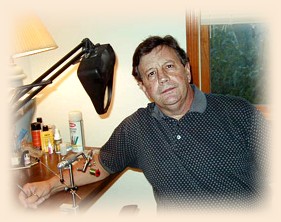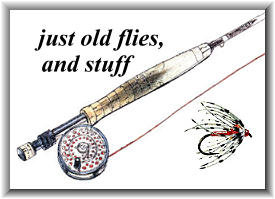I should begin by correcting a small error in last week's article. I maintained that
Mooselookmeguntic and Cupsuptic lakes in Maine retained their original Abenaki Indian
names, and that is very close to being the case. However, as I've since discovered,
Mooselookmeguntic, as it's known today, was originally called Mooselucmaguntic, as
late as 1886. When or why the name changed I'm not sure. Further research is required,
because this is something I must now know.
So the fly is called Mooselucmaguntic, Abenaki for "Where hunters watch the moose by
night", but the lake today is called Mooselookmeguntic.
It is the largest lake in the Rangeley region of Maine. The famous "upper dam", where
Carrie Stevens caught her record brook trout and sold her flies, holds back the lake,
and Haines Landing on the lake was a main stopping-off point in the late 1800s for
sportsmen from all over the East arriving by steamer, in search of huge brook trout.
The Mooselookmegutic House, a 40 room hotel, overlooked the landing, and eventually
the Upper Dam House was built, an even larger hotel with 60 rooms and cabins.
The fly is another one credited to John Shields, who takes credit for many of the wet
flies from the Rangeley region. I found this one to be somewhat difficult to dress, but
maybe it was just me. I had trouble getting the underwing "full" enough to support the
overwing of turkey. The version I've done was found in Carrie Stevens, and was tied by
Robert Warren there. The one shown in Mary Orvis Marbury's Favorite Flies has a solid
yellow underwing of goose or mallard quill, and would be much easier to do. I found it
necessary to do the hard one. It's apparently in my nature.
It's interesting to note that the town of Mooselookmeguntic, Maine is among those with the
longest community names without a hyphen (-) in the U.S. The others are: Kleinfeltersville, PA.;
Chickasawhatchee, GA.; Chancellorsville, VA.; and Eichelbergertown, PA.
While the name of the fly may be a mouthful, I had a great time tying a few of these. Though
the giant brook trout are long gone from the Rangely Region, there is still considerable
fishing there, and I'll discuss that in upcoming articles. Here's the recipe, with more
flies from the Rangeley region coming soon.
Mooselucmaguntic
Tip: Gold tinsel
Tail: Cinnamon turkey
Ribbing: Gold tinsel
Body: Gray floss
Hackle: Chestnut partridge
Wing: Cinnamon turkey over yellow
Credits: Flies by J. Edson Leonard; Carrie Stevens by Graydon R. Hilyard;
Outing Volume Vlll Issue 3 June 1886 "Trout Fishing In Maine" by Ripley Hitchcock; ~ EA
About Eric:
 Eric lives in Delaware, Ohio and fishes for brown trout in
the Mad River, a beautiful spring creek. More of his flies
are on display here:
Traditionalflies.com -- Classic salmon and
trout flies of Europe and the Americas.
Eric lives in Delaware, Ohio and fishes for brown trout in
the Mad River, a beautiful spring creek. More of his flies
are on display here:
Traditionalflies.com -- Classic salmon and
trout flies of Europe and the Americas.
|


 Eric lives in Delaware, Ohio and fishes for brown trout in
the Mad River, a beautiful spring creek. More of his flies
are on display here:
Traditionalflies.com -- Classic salmon and
trout flies of Europe and the Americas.
Eric lives in Delaware, Ohio and fishes for brown trout in
the Mad River, a beautiful spring creek. More of his flies
are on display here:
Traditionalflies.com -- Classic salmon and
trout flies of Europe and the Americas.